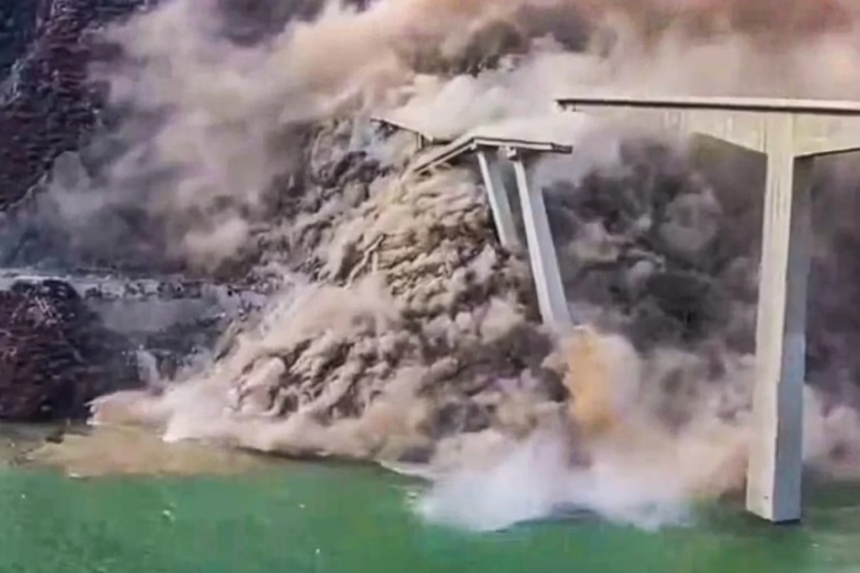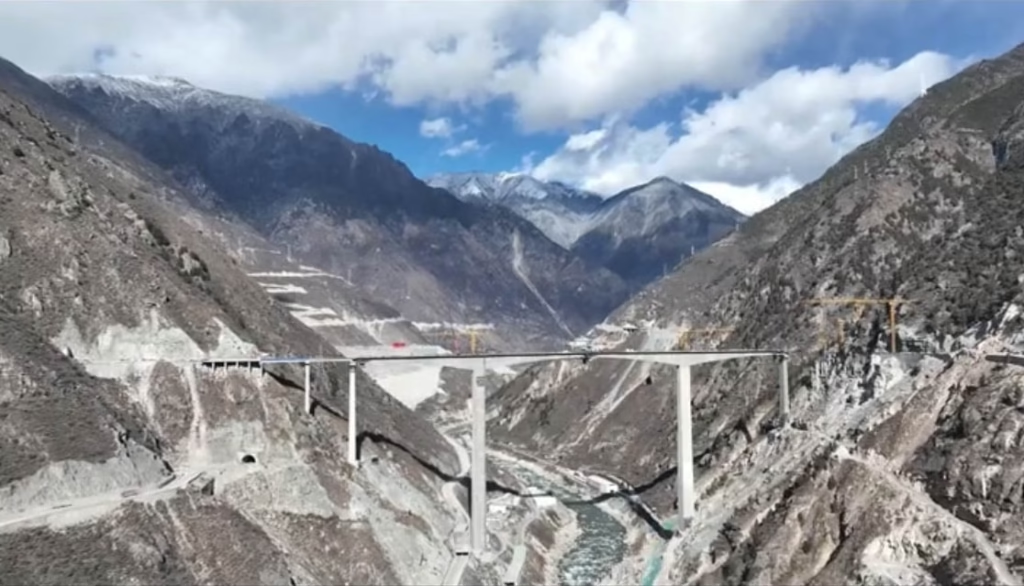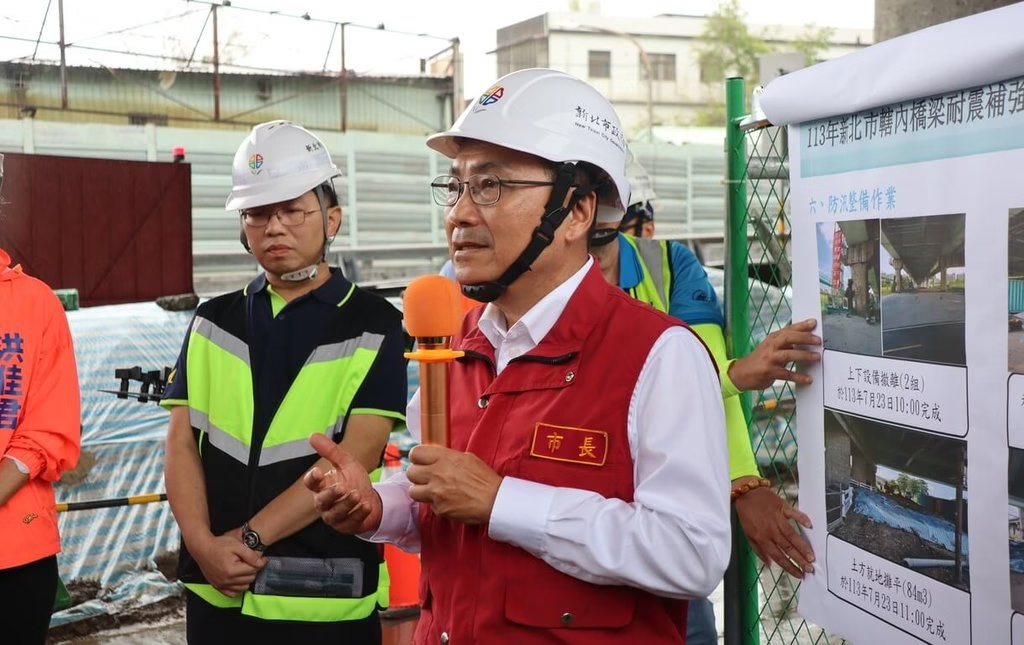SICHUAN, China – A newly opened Hongqi Bridge on the G317 national highway in Sichuan’s Aba Tibetan and Qiang Autonomous Prefecture gave way on 11 November, sending huge sections of concrete and steel into the Dadu River gorge.
The Hongqi Bridge, 758 metres long and central to traffic between China’s interior and the Tibetan Plateau, failed after a severe landslide only months after its launch. No injuries were reported. Local officials had shut the bridge hours earlier after spotting warning signs on the slope and roadway.
Clips posted across Chinese social platforms show a calm mountain scene turning to mayhem in seconds. A wall of dust surged into the sky as the hillside slid, shrouding the area near the Shuangjiangkou Hydropower Station.
Verified footage shows the approach span twisting as tonnes of rock and soil slammed downslope, then sections peeled off and plunged around 625 metres to the riverbed. The collapse, around 3 p.m. local time, trapped thousands of travellers and disrupted supplies bound for Tibet, a stark reminder of the risks of building in one of China’s most quake-prone corridors.
From Prized Project to Rubble
Official notices describe a chain of alerts that started the previous evening. At 5:25 p.m. on 10 November, a routine patrol by transport and public security staff found hairline cracks near the bridgehead and movement on the right-bank slope. Recent heavy rain had soaked the mountainside, and the ground had started to shift. “The slope looked alive,” an engineer told Sichuan Daily, recalling the unnerving scene.
By 6 p.m., police had blocked the bridge and cleared stranded vehicles by 11 p.m. Barriers and warning signs were set up to keep people away. Conditions worsened at first light on 11 November.
Rain tied to the outer bands of Typhoon Fung-wong further weakened the terrain, triggering a major landslide. The torrent of rock and soil battered the foundations, and the approach span and deck broke apart within seconds. CCTV aired the moment nationwide, the structure heaving before pieces snapped and thundered into the valley.
Reuters and the BBC carried updates soon after. Reuters quoted local statements that blamed the failure on deteriorating mountainside conditions. Global Times stressed the swift response, saying traffic controls prevented loss of life. User videos drew millions of views on Weibo. Many mourned the loss and praised the evacuation. “Built for tomorrow, felled by the earth’s force,” one widely shared post read.
Sichuan’s vulnerability is well known. The 2008 Wenchuan earthquake killed nearly 70,000 people, and the province still faces frequent seismic activity. Recent incidents, including an August railway bridge collapse in Qinghai that killed 12 workers, have sharpened public concern about projects in hazardous terrain.
A Short Life for a Symbol of Connection
Finished in just 19 months, the Hongqi Bridge opened to traffic in September 2025 and was hailed as a showcase of modern bridge building. Built by Sichuan Road & Bridge Group at a reported cost above 500 million yuan, the two-lane cantilevered beam bridge crossed the Dadu River near the towering Shuangjiangkou Dam. With a 220 metre main span and piers reaching 172 metres, promotional clips called it a new artery for the G317.
The bridge promised quicker trips between Sichuan’s lowlands and markets on the Tibetan Plateau. Aba Prefecture leaders said it would support ethnic communities, trade, and tourism. Qiang and Tibetan residents, long separated by the gorge, welcomed a safer route for produce, goods, and cultural ties.
Its service was brief. Contractor updates in January 2025 marked the closure pour of the main span, a feat widely praised. By November, the structure lay broken. Specialists say the setting, only a few kilometres from previous quake zones, added danger. Layers of schist in the area can slip when soaked, especially under heavy rain and fluctuating groundwater.
Hongqi Bridge Investigations Begin
Statements from all levels of government sought to explain what happened and what comes next. Maerkang mayor Zhang Wei told Sichuan Television that emergency teams moved fast, cleared the bridge, and prevented casualties.
He called the event a natural disaster, not a lapse in vigilance. A city release said monitoring devices, installed under national rules, flagged the risk in real time. No vehicles were on the span when it fell, and safety and recovery now take precedence.
Liu Min, spokesperson for the Sichuan Provincial Transportation Department, told Xinhua that a joint inquiry had begun. Investigators will review geology, design, and construction quality. Early assessments point to landslide-driven deformation, and a report is expected within 30 days. Seismologists from the China Earthquake Administration have joined the effort to guide stricter standards for high-risk sites.
Sichuan Road & Bridge Group posted a sombre statement via Sichuan Daily. The company said there is no timetable for reopening the highway, and engineers are on site for assessments. The firm had promoted anti-seismic features before the failure. Questions about site selection and long-term slope stability are likely, though officials avoided assigning blame. “This is a hard lesson,” Chairman Wang Hao told reporters. “We will build back better and safer.”
Beijing signalled support for regional efforts. The Ministry of Emergency Management, according to People’s Daily, promised aid for detours along G317, including temporary river crossings. Tibet Autonomous Region governor Che Dalha wrote on Weibo that Tibet stands with Sichuan and will help restore links that serve both regions.
With dust still hanging over the gorge, the fall of the Hongqi Bridge raises bigger questions about construction in fragile mountains. Since the Belt and Road Initiative began, China has built thousands of high-altitude spans that drove growth but also tested environmental limits.
Conservation groups warn that road cuts and deforestation can loosen slopes. Engineers urge wider use of advanced monitoring, from continuous instrumentation to AI-supported alerts.
For Maerkang’s 70,000 residents, many of Qiang heritage, the bridge was more than a road. It stood for access to markets and public services, and a closer link to the national economy. Trader Tashi Dorje told China Times that his yak wool shipments are now stuck, and winter is closing in. Detours add hours to trips, and delays to hydropower deliveries will carry a heavy cost.
Survey teams say parts of the main span may be salvageable, which could speed partial repairs if the slope can be stabilised. Detailed geotechnical work will decide the next steps. Whatever the solution, the project’s legacy now lies in what is learned. In Sichuan’s steep valleys, where the ground remembers every storm and quake, the next bridge will need deeper listening to the mountain before steel and concrete return.
Related News:
4 Dead, 12 Missing After Bridge Collapses in Northwest China














